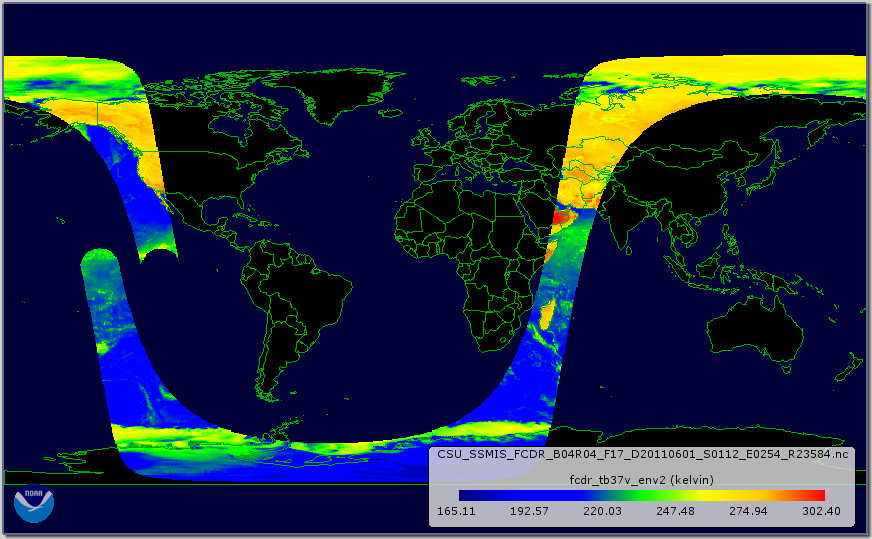NOAA Climate Data Record (CDR) of SSMI(S) and AMSR2 Microwave Brightness Temperatures, CSU Version 2
Access & Use Information
Downloads & Resources
-
NCEI Dataset Landing Page
Landing page for the dataset.
-
SSMI(S) Brightness Temperature - CSU CDR page
Access to the published CDR, source code, and documentation.
-
Dataset Documentation
Direct download location for the CDR documentation and source code files.
-
NCEI Direct Download
Direct download location for the data files.
-
NCEI THREDDS Data ServerHTML
THREDDS catalog for the data files.
-
Registry of Open Data on AWS
Information on AWS data access.
-
AWS S3 Explorer (Region: us-east-1)HTML
Browse view to explore the S3 bucket.
-
Azure Landing Page (Region: us-east)HTML
Information on Microsoft Azure data access.
-
NOAA Climate Data Record Program
Home page for the NOAA CDR Program.
-
Global Change Master Directory (GCMD) Keywords
The information provided on this page seeks to define how the GCMD Keywords...
-
Global Change Master Directory (GCMD) Keywords
The information provided on this page seeks to define how the GCMD Keywords...
-
Global Change Master Directory (GCMD) Keywords
The information provided on this page seeks to define how the GCMD Keywords...
-
Global Change Master Directory (GCMD) Keywords
The information provided on this page seeks to define how the GCMD Keywords...
-
Global Change Master Directory (GCMD) Keywords
The information provided on this page seeks to define how the GCMD Keywords...
-
Global Change Master Directory (GCMD) Keywords
The information provided on this page seeks to define how the GCMD Keywords...
-
Global Change Master Directory (GCMD) Keywords
The information provided on this page seeks to define how the GCMD Keywords...
-
Global Change Master Directory (GCMD) Keywords
The information provided on this page seeks to define how the GCMD Keywords...
Dates
| Metadata Date | August 10, 2023 |
|---|---|
| Metadata Created Date | December 30, 2022 |
| Metadata Updated Date | September 19, 2023 |
| Reference Date(s) | January 31, 2022 (publication) |
| Frequency Of Update | daily |
Metadata Source
- ISO-19139 ISO-19139 Metadata
Harvested from ncdc
Graphic Preview

Additional Metadata
| Resource Type | Dataset |
|---|---|
| Metadata Date | August 10, 2023 |
| Metadata Created Date | December 30, 2022 |
| Metadata Updated Date | September 19, 2023 |
| Reference Date(s) | January 31, 2022 (publication) |
| Responsible Party | DOC/NOAA/NESDIS/NCEI > National Centers for Environmental Information, NESDIS, NOAA, U.S. Department of Commerce (Point of Contact) |
| Contact Email | |
| Guid | gov.noaa.ncdc:C01653 |
| Access Constraints | Cite as: Kummerow, Christian D., Wesley K. Berg, Chia-Pang Kuo, and NOAA CDR Program (2022): NOAA Climate Data Record (CDR) of SSMI(S) and AMSR2 Microwave Brightness Temperatures, CSU Version 2. [indicate subset used]. NOAA National Centers for Environmental Information. https://doi.org/10.25921/E3K5-BW77. [access date]., Distribution liability: NOAA and NCEI make no warranty, expressed or implied, regarding these data, nor does the fact of distribution constitute such a warranty. NOAA and NCEI cannot assume liability for any damages caused by any errors or omissions in these data. If appropriate, NCEI can only certify that the data it distributes are an authentic copy of the records that were accepted for inclusion in the NCEI archives., Use liability: NOAA and NCEI cannot provide any warranty as to the accuracy, reliability, or completeness of furnished data. Users assume responsibility to determine the usability of these data. The user is responsible for the results of any application of this data for other than its intended purpose. |
| Bbox East Long | 180.0 |
| Bbox North Lat | 90.0 |
| Bbox South Lat | -90.0 |
| Bbox West Long | -180.0 |
| Coupled Resource | |
| Frequency Of Update | daily |
| Graphic Preview Description | An orbit of 37.0 GHz vertically-polarized (channel 16) brightness temperature from SSMIS on F17. |
| Graphic Preview File | https://www.ncei.noaa.gov/pub/data/metadata/images/C00827_CSU_FCDR_T37V.png |
| Graphic Preview Type | PNG |
| Harvest Object Id | 6bf0df13-044c-465d-992a-bc32a3ffc2ee |
| Harvest Source Id | 2cb3ef77-1683-4c2a-9119-dc65e50917c6 |
| Harvest Source Title | ncdc |
| Licence | The quality of the output CDR data is dependent on the quality of the input TDR (antenna temperature) data. As such, the near real-time data is labeled as an Interim operational CDR, or an ICDR instead of a final CDR, indicating that it has not yet been fully vetted for climate applications. The ICDR data will transition to final CDR status after the data have undergone further analysis and processing. The expected time lag of the FCDR transition is 6 months to a year. The state of a data file is indicated within each file name., For a complete description of use limitations for this CDR, see Section 6, Assumptions and Limitations, in the respective Algorithm Theoretical Basis Document. |
| Lineage | The data were produced by Colorado State University and are archived at the NOAA National Centers for Environmental Information (NCEI). |
| Metadata Language | eng; USA |
| Metadata Type | geospatial |
| Old Spatial | {"type": "Polygon", "coordinates": [[[-180.0, -90.0], [180.0, -90.0], [180.0, 90.0], [-180.0, 90.0], [-180.0, -90.0]]]} |
| Progress | onGoing |
| Spatial Data Service Type | |
| Spatial Reference System | |
| Spatial Harvester | True |
| Temporal Extent Begin | 1987-07-09 |
Didn't find what you're looking for? Suggest a dataset here.

